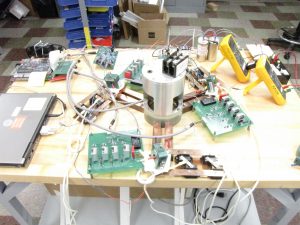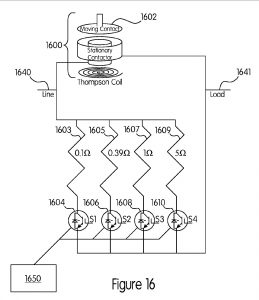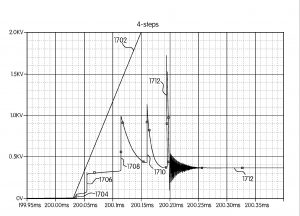This week ‘Science and Science Fiction’ reaches the one-year milestone and I’d like to begin this anniversary post by thanking everyone who has visited my blog over the past year but especially to you my regular readers. I seriously could not have imagined a year ago that this blog would be averaging over 300 visitors a day and that over 4000 people would have become registered blog subscribers or that over 400 of you would leave some very flattering comments. I can only once again give you my thanks.
To celebrate Science and Science Fiction’s first birthday I hope you don’t mind if I’m a little egotistical and use this post to talk about some of my own research, my small contribution to progress. I’m going to talk about my patent.
It’s called a ‘Graded Resistance Solid State Current Control Circuit’ and its registered at the US Patent Office (Reg. US Pat Off: When I was a kid I always wondered what that meant) as US 2012/0243137.
The invention is a circuit that is a part of a design for a new ultra-fast electrical circuit breaker system. Now circuit breakers are needed in any electrical power system because if there’s ever a problem causing a short circuit the circuit breaker will open, eliminating the huge current rush that you get with a short circuit. The picture below shows the breadboard model of the entire circuit breaker. My patent is on the three green circuit boards clustered around the central metal can.

But there’s a problem, large amounts of current don’t want to just stop, electrons have inertia just like any other kind of matter. Trying to just stop a large current quickly in fact will generate a large voltage, the larger the current and the faster it’s eliminated the higher the voltage that is generated, this phenomenon is know as an inductive voltage spike.
The voltage that is generated when a circuit breaker opens can easily be thousands of volts causing huge electrical arcs that can be both dangerous and damaging. I have seen circuit breakers destroyed by doing their job but fortunately I’ve never seen a person injured.
My idea was simple enough, with modern high power solid-state switches instead of just breaking the circuit, as old fashioned mechanical circuit breakers do, we can insert a small resistance, first to control the rapid increase in the current, then add a little more resistance to control the current itself. Finally we insert enough resistance to eliminate the current entirely, hence a ‘Graded Resistance Solid State Current Control Circuit’.
The figure below shows a simplified schematic of the circuit and how it fits into the entire circuit breaker. The object at the top is an ultra-fast mechanical contact that is opened by the same mechanism that is being used in the US Navy’s new rail gun (It’s also the central can in the picture above). My patent is the parts in the figure numbered 1603 to 1610. The even numbers, 1604,1606, 1608 and 1610 are the high power transistors while the odd numbers 1603, 1605, 1607, and 1609 are the increasingly larger valued resistors.

The breadboard model of the entire system has been tested with results similar to that shown in the figure below. The figure below shows the voltage spikes generated as each increase is resistance is inserted. The slanted line 1702 is the maximum voltage that the system can withstand as a function of time. It is easy to see that the voltage remains well below that line, well within safe limits.

So that’s my little invention. The design is being finalized for production and research into improvements is still ongoing. Every engineer wants to invent something completely new and different during their career, and to have it recognized as such. You’ve just had a brief look at mine!
Now tomorrow I’ll be heading down to Tennessee for the total eclipse. I hope the weather’s good so I can grab some images to show you!
